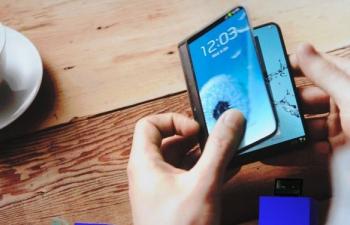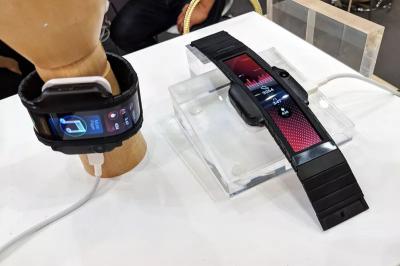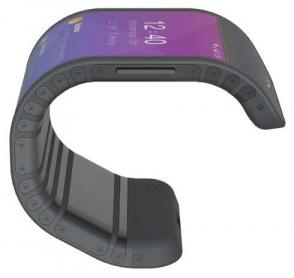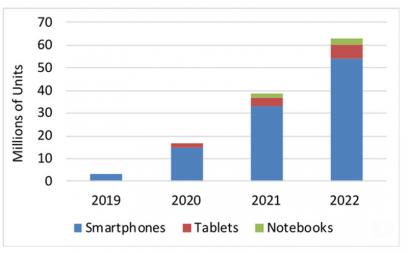In 2013, Samsung announced its YOUM flexible OLED brand, showing off several flexible OLED prototypes - including a foldable phone/tablet. Samsung never used the YOUM brand name again, but the foldable smartphone concept presented in 2013 (see image below) is still exciting consumers - and many of them are still waiting for Samsung to commercialize the technology.

Fast forward to 2015, and the first reports of Samsung's Project Valley started to surface. Samsung started to actually develop a foldable phone, with plans to release its first device in 2016. Samsung faced many challenges - and delays - in its foldable smartphone project (which was recently renamed to Project Winner) - including problems with the substrate and the software and user interface.
In 2016, Samsung Electronics suffered a major blow when it had to halt Galaxy Note 7 production, and reportedly towards the end of 2016 the company decided to accelerate its foldable smartphone project, as it hoped this device will help rebuild its reputation. Looking back it seems that The Note 7 did not effect Samsung's customers, and the company was not rushing to introduce its first foldable device.
In early 2018, Samsung Display seemed to have overcome most of its challenges, and the company started showing an almost-ready first prototype in private meetings. Several Samsung officials have committed to an 2018 launch, and according to our information Samsung Display is set to begin foldable OLED production in November 2018.

Samsung's foldable OLED capacity will be limited at first (ETNews estimates it at 100,000 panels in 2018 and a million panels in 2019) and its foldable device is likely to be a premium device. There are conflicting reports regarding the design itself - but the most likely device is one with two OLEDs - the internal one that is around 6.5 to 7.3 inches in size when open and around 3.5-inches in size when folded, and an external OLED that will be around 3.5 inches in size and used when the device is closed. There are rumors that the device will be called Galaxy F (for Foldable).
Samsung Display is the clear leader in flexible OLED production, and it was always assumed that the Korean display maker will also be the first one to start producing foldable displays. In recent years, however, many other display makers, mostly in China, joined the OLED race and have developed their own flexible and foldable OLED technologies.
China's BOE Display seems to be another leading foldable OLED developer. In May 2018, BOE demonstrated several impressive new technologies, including a 6.2" 1440x3008 foldable (1R) OLED display with a touch layer and a foldable 7.56" 2048x1535 OLED.
In March 2018, Huawei reportedly decided to beat Samsung and become the first company to unveil a foldable phone. Huawei's target is to unveil its device in November, even though actual shipments will not commence until 2019. Reports suggest that Huawei's foldable OLED supplier is BOE Display, even though some early rumors suggested that Huawei's supplier is LG Display. We detail LGD's foldable OLED project below.
BOE Display is also working with other phone makers on foldable devices - in fact ETNews says that there are three companies (including Huawei) and four different devices under development.
Huawei and Samsung indeed seem to have at least one more competitor that may beat them in this race. In September 2018, Chinese smartphone maker Nubia unveiled its first foldable device, the Nubia Alpha. The Alpha uses a tall and slim foldable OLED and turns from a slim phone to a wearable smartwatch. Nubia claims that the device will ship in China by the end of 2018. The producer of the Nubia Alpha's display is China-based Visionox, who may yet become the world's first foldable OLED producer if Nubia does indeed release its device by the end of 2018.

Besides Samsung, Visionox and BOE, other display makers have demonstrated foldable OLEDs, but it seems that none are as mature as Samsung and BOE. LG Display has been reportedly collaborating with Apple, Google and Microsoft on this project (this hasn't been confirmed) but its plans are to release its first panel only in 2020. Tianma also demonstrated foldable OLEDs in 2018, and so did Everdisplay and Royole- but it does not seem as if these companies are ready to begin production in the near future.
In December 2016, Lenovo demonstrated two foldable device prototypes - The CPlus smartband and the Folio tablet-smartphone one. In 2017, Lenovo said that its first foldable device could ship by 2019-2020. It is possible that the company is BOE's third foldable OLED customer.

So - we have Samsung, Huawei, Nubia and perhaps Lenovo. We do not know yet who will be the first company to unveil its foldable device, but it seems that 2019 will be the year of the foldable OLED. Market analyst firm DSCC estimates that by 2022 the market for foldable OLED will reach 63 million units, up from 3 million in 2019 (a CAGR of 173%).


